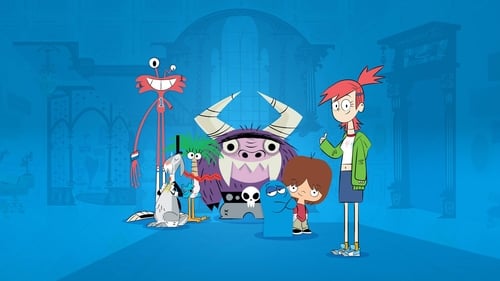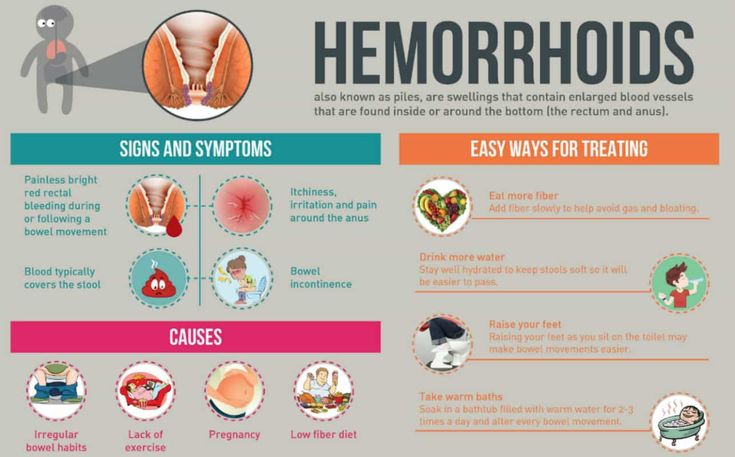How to comfort your inner child
8 Tips for Healing Your Inner Child
Everyone has an inner child.
You might see this inner child as a direct representation of yourself in your early years, a patchwork collection of the developmental stages you’ve passed through, or a symbol of youthful dreams and playfulness.
An awareness of your inner child can help you think back to lighter, carefree years, explains Dr. Diana Raab, author and research psychologist. “Being in touch with the joys of childhood can be an excellent way of dealing with challenging times.”
Not everyone associates childhood with playfulness and fun, though. If you experienced neglect, trauma, or other emotional pain, your inner child might seem small, vulnerable, and in need of protection. You may have buried this pain deep to hide it and protect yourself — both your present self and the child you once were.
Hiding pain doesn’t heal it. Instead, it often surfaces in your adult life, showing up as distress in personal relationships or difficulty meeting your own needs. Working to heal your inner child can help you address some of these issues.
Healing your inner child can take time, but these eight tips are a good starting point.
To begin healing, you first have to acknowledge your inner child’s presence.
As Kim Egel, a therapist in Cardiff, California, points out, anyone can get in touch with their inner child — if they’re open to exploring this relationship. If you feel doubtful or resistant to the idea of exploring the past, you’ll have a harder time beginning the healing process.
If it feels a little strange or awkward to imagine opening up to your child self, trying thinking of inner child work as a process of self-discovery.
Briefly set aside the existence of your inner child and just think of a few key childhood experiences. While some were probably positive, others may have hurt or upset you. Perhaps you still carry the emotional pain from those events today.
The process of acknowledging your inner child mostly just involves recognizing and accepting things that caused you pain in childhood.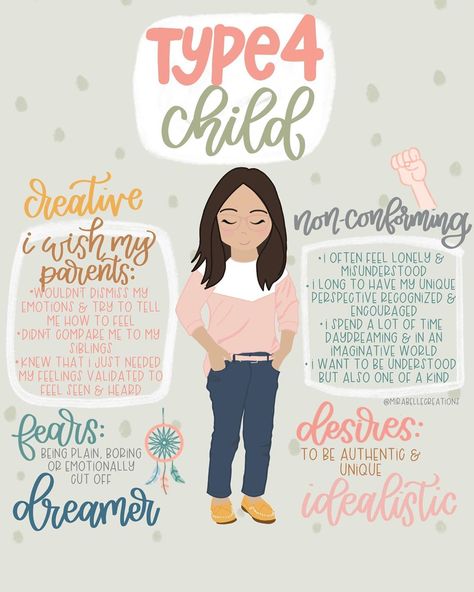 Bringing these hurts out into the light of day can help you begin to understand their impact.
Bringing these hurts out into the light of day can help you begin to understand their impact.
That said, many people do find it helpful, even soothing, to address their inner child as they would a living person, so don’t feel afraid to give it a try.
After opening the door to a connection with your inner child, it’s important to listen to the feelings that enter.
“These feelings often come up in situations that trigger strong emotions, discomfort, or old wounds,” Egel explains.
You might notice:
- anger over unmet needs
- abandonment or rejection
- insecurity
- vulnerability
- guilt or shame
- anxiety
If you can trace these feelings back to specific childhood events, you may realize similar situations in your adult life trigger the same responses.
Here’s an example:
Your partner suddenly becomes busy with work and doesn’t have time for the big night out you’d planned. While you know they’d prefer to spend time with you, you still feel rejected and frustrated. Your disappointment manifests in a childlike way, with you stomping off to your room and slamming the door.
Your disappointment manifests in a childlike way, with you stomping off to your room and slamming the door.
Considering what happened through the eyes of your inner child can offer some valuable insight in this scenario.
You realize your partner’s sudden need to work made you feel just as you did when your parents canceled plans, playdates, even your birthday party, because of their busy schedules.
In this way, listening to the feelings of your inner child and letting yourself experience them instead of pushing them away can help you identify and validate distress you’ve experienced — an essential first step toward working through it.
To open a dialogue and start the healing process, Raab recommends writing a letter to your inner child.
You might write about childhood memories from your adult perspective, offering insight or explanations for distressing circumstances you didn’t understand back then.
Maybe you didn’t know why your brother always shouted at you and smashed your toys, but you learned to fear him all the same. If you’ve since realized he experienced years of bullying and abuse, his rage may begin to make sense. Sharing this revelation with your inner child can help soothe some of that lingering pain.
If you’ve since realized he experienced years of bullying and abuse, his rage may begin to make sense. Sharing this revelation with your inner child can help soothe some of that lingering pain.
A letter can also give you the chance to offer messages of reassurance and comfort.
A few questions can also help keep the dialogue going:
- “How do you feel?”
- “How can I support you?”
- “What do you need from me?”
Sitting with these questions can often lead to answers, though it may take some time before your inner child feels safe and secure.
Those questions you asked your inner child? Meditation can be a great method of opening yourself up for answers.
Meditation has plenty of benefits for physical and mental health, but a few of these relate directly to inner child work.
For one, meditation boosts mindful self-awareness, teaching you to pay more attention to feelings that come up in daily life. Greater mindfulness around your emotions makes it easier to notice when specific situations trigger unhelpful reactions.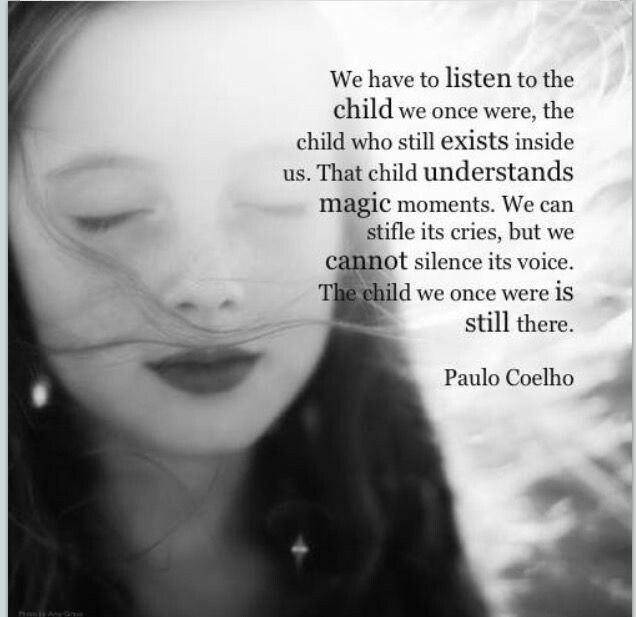
Meditation also helps you get more comfortable with unwanted emotions.
Children often have a hard time naming uncomfortable emotions, especially when they aren’t encouraged to express themselves. They may repress or bury these feelings to avoid punishment or earn praise from caregivers for being “good” or maintaining control.
Emotions, positive or negative, are meant to be experienced and expressed. Repressed emotions usually just show up somewhere down the line, often in unhelpful, even harmful ways.
Meditation helps you practice acknowledging and sitting with any feelings that come up in your life. When you get used to accepting emotions as they come, you’ll find it easier to express them in healthy ways. This helps validate your inner child’s feelings by sending the message that it’s OK to have emotions and let them out.
You can also try loving-kindness meditation to send feelings of love to your child self. Egel also recommends visualization meditation as a useful tool for picturing your inner child, or even “visiting” them as your adult self.
Many people find journaling a great way to sort through challenging or confusing experiences and emotional turmoil. If you keep a journal, you might already get a lot of benefit from this coping strategy.
Just as journaling can help you recognize patterns in your adult life that you want to change, journaling from the perspective of your inner child can help you recognize unhelpful patterns that began in childhood.
For this journaling exercise, set your present self aside for the moment and channel your child self. Try photos or a brief visualization exercise to help recall how you felt at the specific age you’re intending to explore.
Once you’re in the right mindset, write down a few memories and any emotions you associate with those events. Try not to think too carefully about what you’re writing. Just let the thoughts flow onto the paper as they come up. Expressing them in an unchecked way can help you get to the heart of your inner child’s pain.

Adulthood certainly comes with plenty of responsibilities, but relaxation and playfulness are both essential components of good mental health.
If your childhood lacked positive experiences, getting back in touch with your playful side and making time for fun can help heal the pain of missing out on what you needed as a child.
It’s also important to enjoy small pleasures, like ice cream after a walk, games with your partner or children, and laughter with friends.
Whatever you do, making regular time for fun and lightheartedness in your life can help rekindle the positive emotions of youth.
Healing doesn’t always have a definite end. It’s often more of an open-ended journey.
You’ve started the process by reaching out to your inner child. Now you can cultivate this newfound awareness and continue listening for your child self’s guidance as you move forward.
Your child self may have more to reveal about challenges from the past. But you can also learn to become more spontaneous and playful and consider what life has to offer with a greater sense of wonder.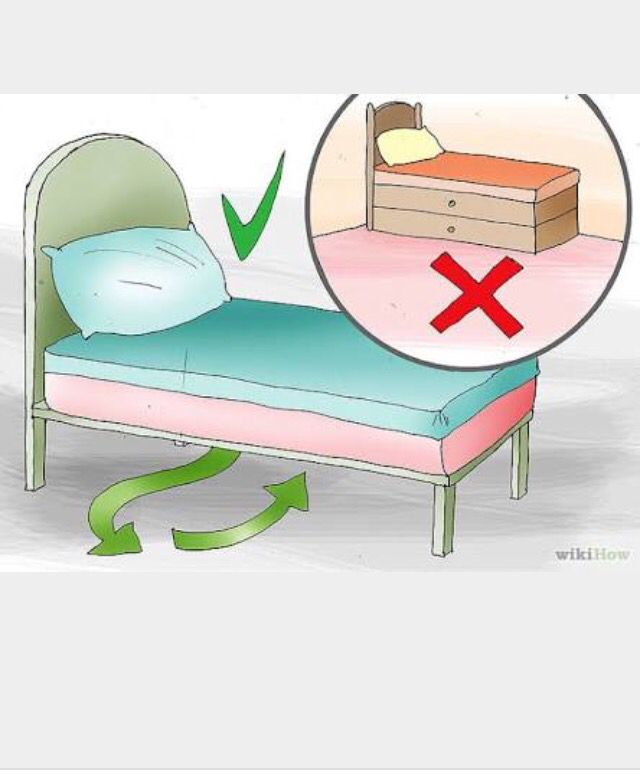
Staying in tune with your inner child can lead to a more complete sense of self and boost confidence and motivation. Reinforce the connection you’ve opened by affirming your intent to continue listening, offering love and compassion, and working to heal any wounds that remain open.
Past trauma can cause a lot of distress. Therapists attempt to create a safe space for you to begin navigating this emotional turmoil and learn helpful strategies for healing your inner child.
Therapists typically recognize how childhood experiences and other past events can affect your life, relationships, and overall well-being. But not all types of therapy prioritize exploration of past events or related concepts, such as the inner child.
Cognitive behavioral therapy, for example, is considered a highly effective treatment approach, but it generally focuses on your experiences in the present.
If you’re interested in doing some exploration of your past and getting to know your inner child, look for a therapist who has experience in this area.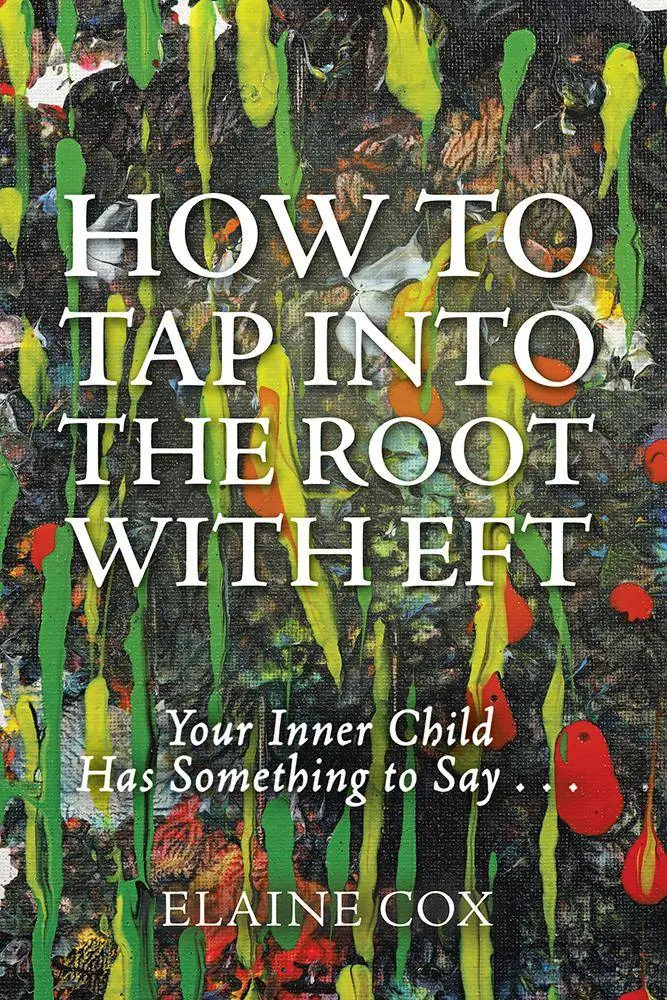 Typically, psychodynamically oriented psychotherapy can be a good fit.
Typically, psychodynamically oriented psychotherapy can be a good fit.
Inner child therapy, also called inner child work, specifically focuses on this process, but other types of therapists can also offer support. It always helps to let potential therapists know the specific concerns you’d like to explore.
When needs for love, recognition, praise, and other types of emotional support go unmet in childhood, the trauma that results can last well into your adult life.
But it’s never too late to heal. By learning to nurture your inner child, you can validate these needs, learn to express emotions in healthy ways, and increase self-compassion and self-love.
Crystal Raypole has previously worked as a writer and editor for GoodTherapy. Her fields of interest include Asian languages and literature, Japanese translation, cooking, natural sciences, sex positivity, and mental health. In particular, she’s committed to helping decrease stigma around mental health issues.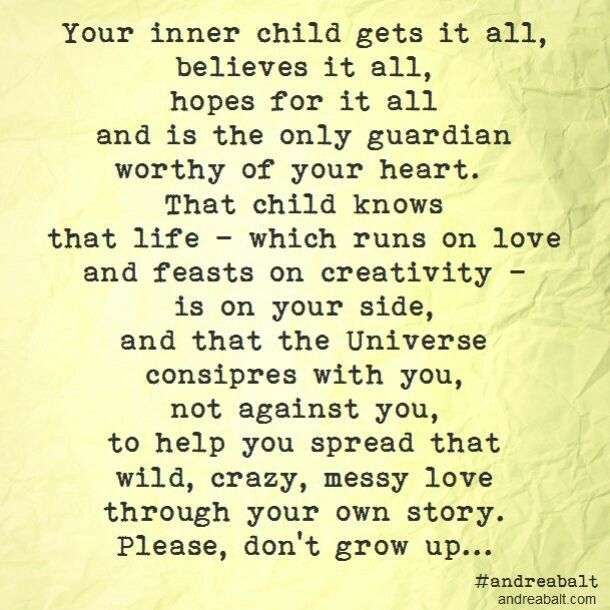
5 Self-Soothing Tips To Heal Your Inner Child
Allow yourself to grow.
Unsplash- Brooke CagleBy Sarah Jeanne Browne—
“No one’s going back for that inner child. Except you.” ~Tanya Markul
Everyone has an inner child. Your inner child is You but it’s not a childlike personality you have held onto all these years. It’s your unconscious mind. It’s the You that has all those repressed memories and feelings from your childhood that resurface from time to time. Healing your inner child is essential to wellbeing and growth.
Signs Your Inner Child Might Be Trying To Reach YouAccording to American Psychological Association, “Research has found that relationships between parents and caregivers and youth that:
- Are warm, open, and communicative;
- Include appropriate limits, and
- Provide reasoning for rules for behavior
are associated with higher self-esteem, better performance in school, and fewer negative outcomes such as depression or drug use in children and teenagers. ”
”
Caregiver relationships impact social, cognitive, emotional and mental health. What happens when a child doesn’t receive a supportive relationship from a caregiver? An unmet childhood need for unconditional love and safety drives your inner child the most. You are most shaped by the early years of your life with the caregivers who surround you at that time. There are triggers, trauma responses and self-protection practices that may be in play if your inner child is provoked.
MORE FROMFORBES ADVISOR
If Jane goes to her husband for validation and one day, he is too busy to give her a compliment, she may feel unseen and unheard. Her inner child longing for attention may be triggered. Jane then starts a fight over something seemingly small but big to her. She feels rejected even if her husband wasn’t intending this. Such a reaction happens often when the inner child is triggered. Anger as a secondary emotion comes out.
You relive the feelings of abandonment even if you are now in a healthier relationship. Intimacy may be more difficult to master due to projection of past pain. These triggers can also be simply being overwhelmed or stress or feeling like no one appreciates you. Triggers are different for each person.
Intimacy may be more difficult to master due to projection of past pain. These triggers can also be simply being overwhelmed or stress or feeling like no one appreciates you. Triggers are different for each person.
Trauma responses may also show up in the following ways:
- Not asking for help
- Avoidance
- Saying “I’m fine” when you are not
- Feeling like a burden
Your self-protection practices might be in perfectionism, people-pleasing or power hunger as well as more. There are many ways this can manifest. You try to overcompensate for the neglect you once experienced as a child. You feel like you aren’t enough as you are, so you try even harder. Repression doesn’t help the situation. Your inner child will find a way through. It can be manifested in anxiety, depression, PTSD, emotional dysregulation, impulsivity, outbursts, difficulty functioning and withdrawal from others. If you ignore it, it just gets stronger. It’s often trying to tell you something is wrong.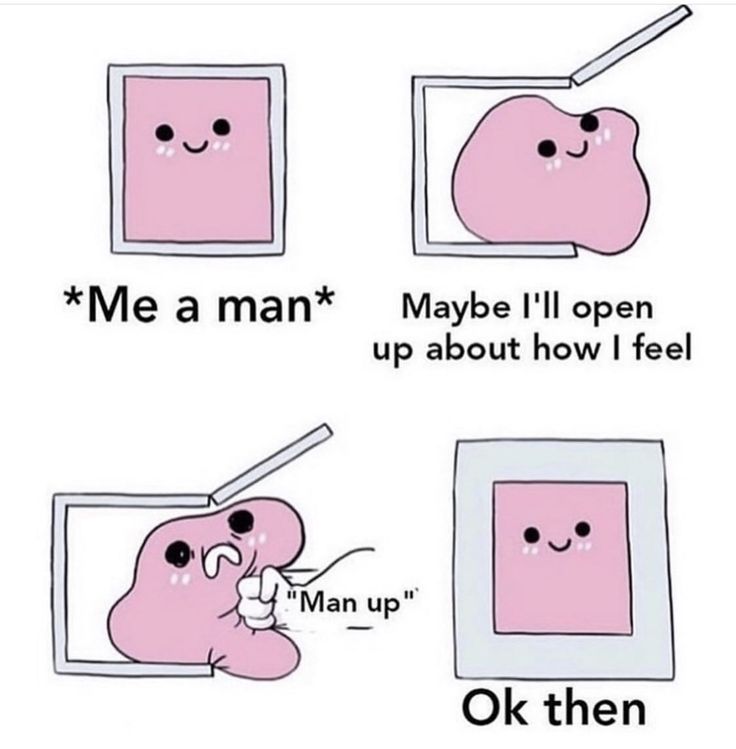 If it takes over your life, that’s when it’s time to reach out to a mental health professional for the best care.
If it takes over your life, that’s when it’s time to reach out to a mental health professional for the best care.
Unresolved trauma can be the root of your struggles. Trauma can look like all sorts of things. According to Aundi Kolber, there’s “Big T trauma”—things like abuse, neglect, natural disaster, severe accident or experiencing a loss. Then there’s “little t trauma.” That’s when things happen that can seem as small as a paper cut (or insignificant) but over time, those cuts multiply and cause a lot of pain. Trauma is anytime your nervous system is overwhelmed and you exceed your window of tolerance for difficult emotions. Trauma can look different for each person. Therefore, comparison of trauma is an irrelevant aim. Trauma can affect your attachment styles, resulting in “attachment trauma.”
There are two types of attachment styles you have growing up—insecure and secure. Insecure looks like inconsistency and injustice. Secure is consistent and emotional support. Dr. Bruce Perry says that sometimes, you may experience patternless caregiving or care that is a mix of support and neglect.
Dr. Bruce Perry says that sometimes, you may experience patternless caregiving or care that is a mix of support and neglect.
According to Very Well Mind, “Thanks to neuroplasticity, the brain will begin to change as a person changes their behavioral patterns and beliefs. A person who is insecurely attached can build the security they need by integrating new, supportive, loving experiences into their lives.”
How To Engage With Your Inner ChildHealthline says merely acknowledging your inner child is the first step to healing and that it is “a process of self-discovery.”
Mindfully embrace the inner child with self-compassion. Mindfulness is simply being present and in tune with yourself. Sit with the inner child. Avoid judging your thoughts, but instead observe them objectively and thank them for existing. Allow them to have their space. Your inner child repressed things because it was afraid to take up space. It’s time to express that pain. It’s time to reclaim your childhood.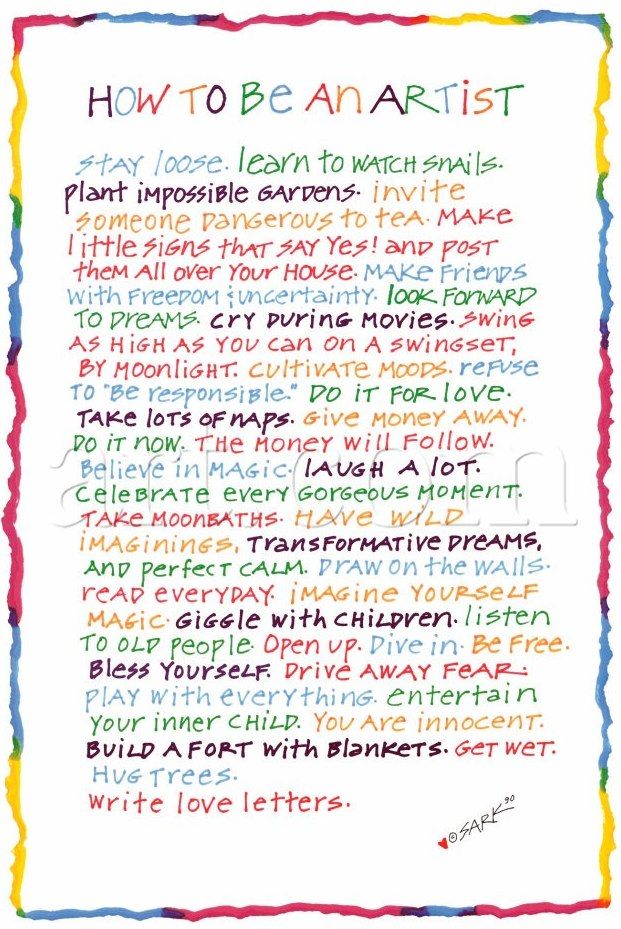 It’s time to start again.
It’s time to start again.
Some backdraft may come up when you show yourself compassion. Repressed pain may come up on the road to healing. If it is too much, try grounding. Focus on your senses to pull yourself into the present. That way, your inner child won’t take over completely without consent.
Reparent Your Inner ChildNotice then nurture the inner child. There are many exercises you can try in Dr. Stefanie Stahl’s book, The Child In You: The Breakthrough Method For Bringing Out Your Authentic Self. For example, try this memory exercise: Note how you handled life recently such as unhealthy ways or negative thoughts. Think of some events. What self-protection strategies can you observe in your behavior? Connect these to what beliefs you developed in childhood which influence those.
Notice it to change it. Figure out which negative belief stems from conditioning and childhood programming. Reshape reality through your inner adult.
Dr. Stephanie Stahl says to strengthen your inner adult by having it challenge childhood beliefs from neglect or abuse. Combat negative thoughts such as “I don’t deserve love because my parents didn’t show me it” with “I was just a child who deserved love and safety and still do.”
Stephanie Stahl says to strengthen your inner adult by having it challenge childhood beliefs from neglect or abuse. Combat negative thoughts such as “I don’t deserve love because my parents didn’t show me it” with “I was just a child who deserved love and safety and still do.”
This is how you start to reparent yourself.
Dianna Raab, PhD, author of Writing for Bliss, says to try to write a letter to your inner child. It’s important to create a dialogue that is welcoming and warm. Show compassionate attention to yourself.
Here are prompts to get you started when addressing your inner child. Ask yourself,
- What are some things you wanted a trusted adult to tell you at that age?
- What is something kind you can say about yourself?
- How can you forgive yourself for not knowing then what you know now?
- How can you release the shame of what you’ve been through?
- What wisdom can you learn from the wounded inner child?
If anything, affirmations such as “I love you” and “I’m sorry we went through that” are extremely helpful.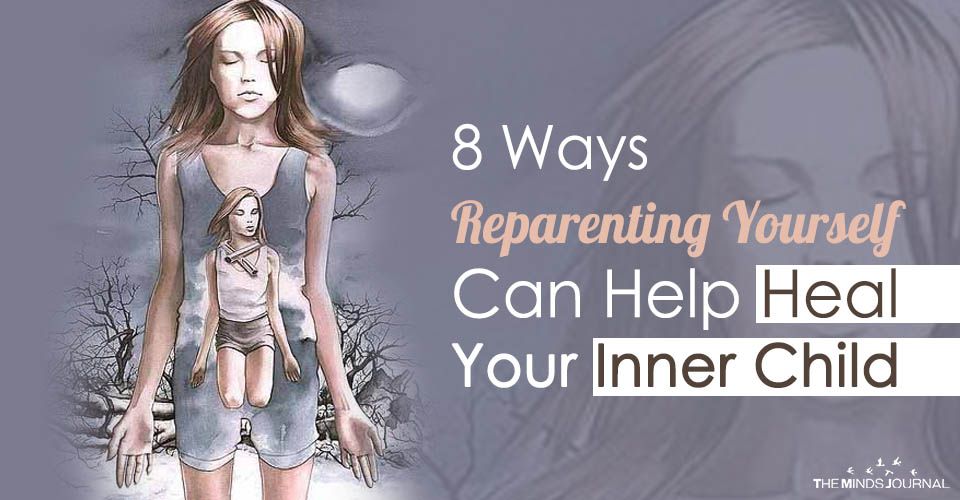
Oxytocin is a hormone that is released when you feel love and safety. Its benefits are stress relief, improved immunity, sleep, relaxation and positive thinking. When a child is neglected by a caregiver, it may prohibit the release of oxytocin among other hormones such as dopamine.
According to the study, Effects of Oxytocin On Recollections of Maternal Care and Closeness, it is noted “Oxytocin is produced in the hypothalamus and released into the circulatory system, where it is involved in facilitating uterine contractions during parturition and milk ejection during lactation. Oxytocin also is released directly into the brain, where it has been shown to play a critical role in attachment bond formation and maintenance in animals.”
The good news is that there are ways to release oxytocin in the brain, and there are even studies exploring the administration of oxytocin to children to create feelings of trust and safety if deprived in some way.
You can release oxytocin as an adult and cope with your inner child in the following ways:
- Massage by yourself or someone else. For self massage- See this tutorial by Gentle Whispering ASMR for how to do so!
- Yoga—This lowers blood pressure and reduces stress.
- Bath—Soak yourself in warm water and bubbles and let your thoughts drift away.
- Weighted Blanket—It will feel like a hug!
- Listen to or make music—Create a self-care playlist.
- Meditation—A great meditation you can do is Inner Child Healing Meditation on Youtube by Relax for a While.
- Foster Connection—A support system and social activity will help you heal.
- Intimacy—Hug, cuddles or sex or anything where you express physical closeness with someone.
- Pet animals—There’s a reason there are emotional support pets. Even if you don’t get one, you can still enjoy the presence of an animal.
Eventually, you’ll embrace your inner child as a part of you unforgotten. You will realize things weren’t your fault. You had to survive by white-knuckling and other ways of forcing the inner child down. But now you can let it seek refuge. Healing isn’t an overnight thing. It’s human to sometimes have to revisit certain issues. You can focus on it bits at a time. You don’t have to solve all your childhood trauma in one sitting. But your inner child will thank you for finally letting it come to the light.
You will realize things weren’t your fault. You had to survive by white-knuckling and other ways of forcing the inner child down. But now you can let it seek refuge. Healing isn’t an overnight thing. It’s human to sometimes have to revisit certain issues. You can focus on it bits at a time. You don’t have to solve all your childhood trauma in one sitting. But your inner child will thank you for finally letting it come to the light.
Sarah Jeanne Browne is a speaker, writer and activist who has been published on Lifehack, Tiny Buddha, Thrive Global and more. See @sarahjbrowne.
Healing the inner child: how to prevent childhood trauma from ruining adult life
June 16, 2021 Likbez Life
Perhaps the roots of your problems lie in the distant past.
You can also listen to this article. If it's more convenient for you, turn on the podcast:
If it's more convenient for you, turn on the podcast:
What is the inner child
This concept refers to any emotional and psychological baggage that a person carries from the first years of life.
The first person to talk about the inner child was the psychiatrist Carl Jung. According to his theory, the inner child archetype helps a person to reconnect with the past, because he remembers his childhood emotions and experiences. So it is easier for him to grow up and understand what he wants from the future.
The concept became popular after the release of John Bradshaw's bestselling book Coming Home: Reviving and Protecting the Inner Child in 1990. Modern psychological research confirms that early experiences are well remembered. They affect people in different ways. For example, for some, eternally critical parents have become an occasion to cultivate fortitude, for others, this is a trauma for life.
Why look for the inner child
Diane Raab
PhD, Healthline commentary
We all have an inner child. Communicating with him can make your life more prosperous and bring ease into it.
Communicating with him can make your life more prosperous and bring ease into it.
When the inner child is "healthy", it usually does not cause trouble in adult life. But if he is "wounded", the person may repeat the wrong behaviors instilled in childhood. For example, a little girl who has seen her mother endure abuse from her father may contact the abuser herself in adulthood.
Communication with the inner child allows you to find the roots of current problems in childhood and get rid of them. Some get the following in the process:
- release repressed emotions;
- recognize unmet needs;
- change wrong behavior patterns;
- loosen up;
- increase self-esteem.
How to find the inner child
Anyone can contact and benefit from it. But sometimes disbelief and resistance become an obstacle.
If there is still skepticism, that's fine. Just try to look at the inner child not as a separate person, but as your past experience.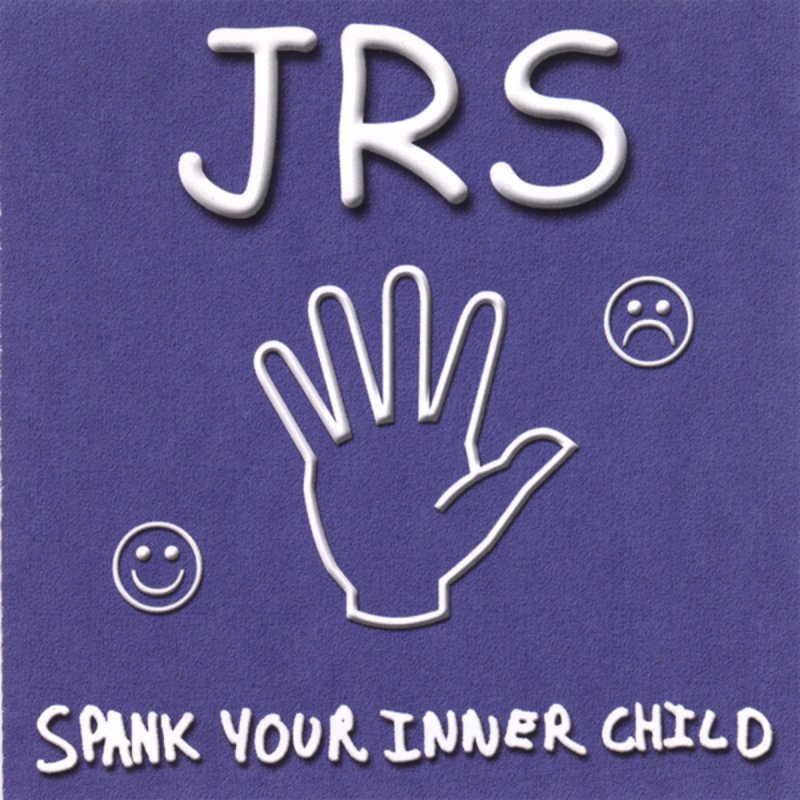 This will help you approach your search with curiosity.
This will help you approach your search with curiosity.
There are several ways to find the inner child.
Spend time with children
Playing with them will help you remember pleasant events from the past, learn to enjoy the little things, live in the moment, relax and feel happier. To get started, try, for example, hide and seek.
Children's fantasies sometimes emerge through imaginative play. Maybe before you imagined some scenarios, thanks to which you easily experienced difficult moments.
If you don't have your child yet, you can stay with the children of your friends or relatives.
Reminisce about your childhood
Try leafing through photo albums, reread books and watch movies you once liked. If you have kept a diary, take a look at it. Ask relatives to share their memories of you. All this helps to return to the childish emotional state and connect with the inner child.
Another way to delve into the past is through a visualization exercise.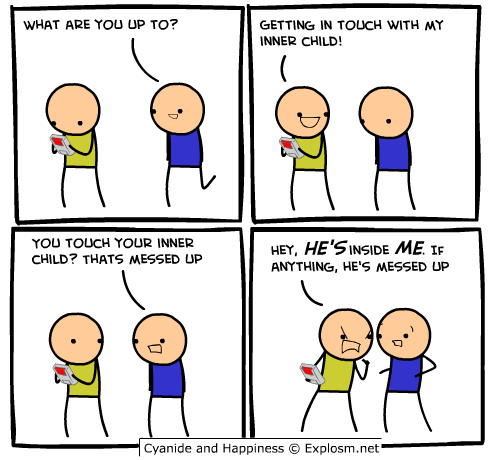 If you're having trouble remembering what you looked like as a child, look at old photos first. Then close your eyes and imagine yourself as a child. The image must be detailed. Think about what you are wearing, where you are, whether there is someone nearby. How are you feeling? A child can be lost, lonely, insecure, contented, strong.
If you're having trouble remembering what you looked like as a child, look at old photos first. Then close your eyes and imagine yourself as a child. The image must be detailed. Think about what you are wearing, where you are, whether there is someone nearby. How are you feeling? A child can be lost, lonely, insecure, contented, strong.
During the exercise, sometimes it turns out that the inner child feels good, gives you strength, optimism. If he is suffering, you need to help him.
Do something you used to enjoy
Think about what you liked to do as a child. Maybe every summer they cycled to the creek, swam, fished, read in a dusty attic, or roller-skated. Perhaps now you have little entertainment that simply brings happiness.
Drawing and coloring can also help. During these activities, the active mind rests, so emotions that you do not pay attention to will appear on paper. Some of them may be related to the inner child.
Write a letter to your inner child
This is a powerful tool for connecting with your inner child.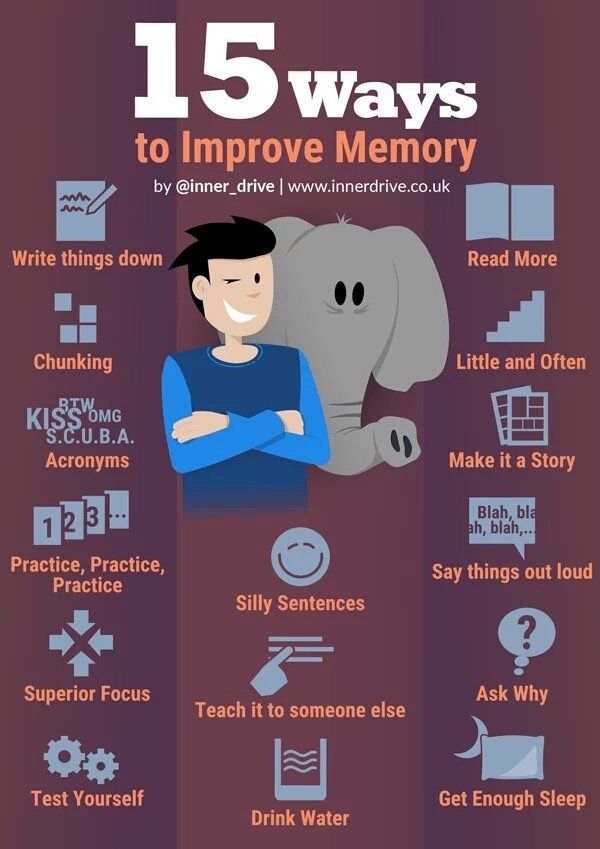 Writing will help deal with childhood experiences and emotions. There are no restrictions on the form of the exercise. You can talk about something specific or express any thoughts that come to mind.
Writing will help deal with childhood experiences and emotions. There are no restrictions on the form of the exercise. You can talk about something specific or express any thoughts that come to mind.
Diana Raab
If you have wounds or injuries, write about them. This will help you connect with your inner child. During reunion with him, you can find the causes of adult phobias, fears and life stereotypes. Perhaps you understand why you have become the way you are.
Another way to get the inner child to talk is to ask him questions from the adult self, then let him answer and analyze the result. It's normal to be nervous about what a child might say. Especially if in childhood you experienced difficult emotions or you had a negative experience.
If you don't like the format of the letter, try talking out loud to your inner child.
Consult a psychotherapist
If you suspect that the connection with the inner child will bring up bad memories or feelings of fear, it is better to go to a psychotherapist. A therapist will support you and suggest strategies to help you cope with your emotions and trauma.
A therapist will support you and suggest strategies to help you cope with your emotions and trauma.
It is better if you find a therapist who has experience working with the inner child. The expert must know how to contact him and understand if he is suffering. If it turns out that the client had childhood traumas that are causing problems now, the specialist will offer psychotherapy.
How psychotherapists heal the inner child
Childhood trauma has long-term consequences. Therefore, if during communication with the inner child you realized that he was hurt or offended, he needs to be healed. This can be done with a psychotherapist. Experts have several techniques to help.
Empty Chair Technique
The therapist asks the client to sit in front of an empty chair and imagine that someone is sitting on it. For example, a parent or other relative. This person needs to be told about his feelings and thoughts, to explain what was missing from him in childhood. Also, a specialist may offer to change places with an imaginary character. For example, imagine yourself as your grandmother and listen to your inner child.
Also, a specialist may offer to change places with an imaginary character. For example, imagine yourself as your grandmother and listen to your inner child.
In therapy, you can get to know feelings from the past better and realize how they affect adult life. Some patients get to know the sides of the character that they tried to deny.
Schema therapy
People who grew up in a hostile environment often exhibit maladaptive (incorrect) behavior patterns. Because of them, difficulties in relationships or with self-control can arise.
Schema therapy helps to get rid of problems that appeared in childhood. The key to success is that the therapist uses the re-education technique to meet the emotional needs of the person. For example, praise him. As a result, the patient changes his mind about himself and learns new patterns of behavior.
Eye Movement Desensitization and Reprocessing
This type of therapy helps to cope with panic attacks, stress, painful memories and intrusive thoughts caused by childhood trauma.
During the session, the person focuses on bad thoughts, emotions or sensations. The therapist begins to move his hand left and right, and the patient follows the movement. Depending on which way the eyes look, the left or right hemisphere is activated. At this point, the brain begins to process negative information.
How to help the inner child on your own
Visualization is a way of healing that you can try yourself. The method is based on the fact that when we think about an action, the same parts of the brain begin to work as during execution.
Use your imagination and imagine yourself as a child at any stage of development where you have experienced stress or abuse. It could be your five year old self or your teenager. If necessary, consider that the child is adopted.
Visualize another inner self that will help heal the child. For example, a parent, advocate, compassionate, or therapist. Who exactly it will be is up to you.
The method is that you must re-educate yourself.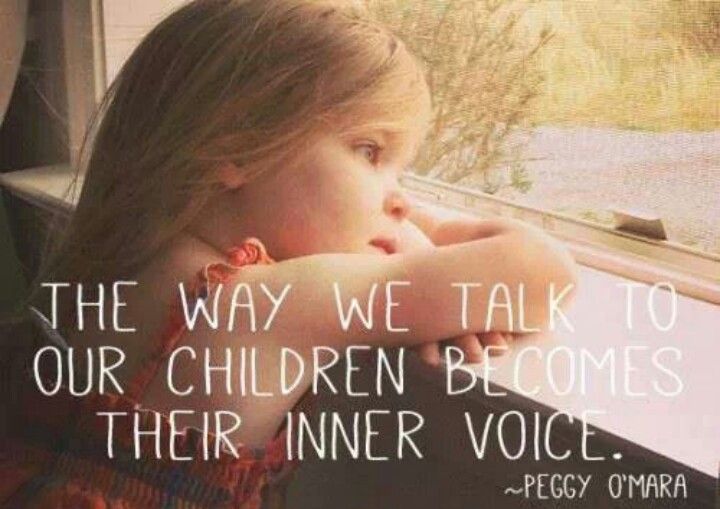 Everything must be done to make the child feel safe and develop resilience. Let the second inner “I” take care of him, approve, satisfy his needs.
Everything must be done to make the child feel safe and develop resilience. Let the second inner “I” take care of him, approve, satisfy his needs.
Read also 🧐
- How to stop blaming yourself for all mortal sins
- 10 subtle signs that you don't like yourself
- How to deal with toxic people
- 20 questions to help you understand yourself better
- This is not irresponsibility! 6 Things You Shouldn't Blame Yourself For
How to Heal Your Inner Child | Publishing House AST
In esotericism, the inner child is called the unconscious part of the personality. It stores childhood memories, including anxiety, fear and pain. If a person does not overcome these traumas, they will constantly torment him in similar situations in adulthood.
To heal your inner child, show yourself love and compassion. This is what a psychologist, esotericist and blogger with a million audience Dasha Gorod advises. Meditation will help you with this. To do this exercise correctly, imagine yourself as a child. The girl explains why and how to do it.
To do this exercise correctly, imagine yourself as a child. The girl explains why and how to do it.
How the inner child reflects your relationship with your parents
The love of parents determines how happy and harmonious a child grows up. If in childhood they were callous or even cruel to him, his adult life will be full of complexes, resentment and fears. He will react painfully to those actions and emotions for which he was scolded or forbidden to him in childhood.
You cannot change the past. And blaming parents for not getting enough love, support and care is pointless. But you can help yourself. Give your inner child what he didn't get as a child.
What is meditation
Translated from Latin, meditation means “thinking”. This is a spiritual practice that allows you to find harmony with the inner world. It includes breathing exercises and concentration to help you relax.
To meditate, you do not need to immerse yourself in Hinduism and Buddhism.Long before meditation became part of Indian yoga, it was mentioned in antiquity and other cultures. You can master it on your own if you practice regularly.
How to heal the inner child with meditation
- Sit in a comfortable position, relax and take 2-3 deep breaths in and out.
- Imagine that you are walking down a long corridor with a light in front of it. On your right side there are doors with signs. On one of them you see a number that corresponds to your age. You go further, and the numbers start to decrease: 25...21...18...16...12, etc.
- Stop at the door marked 5 and enter it. Carefully inspect the room: furniture, walls, floor. Open the window: look at the view, smell the street, listen to the sounds.
- Close the window and turn around. You will see a child in front of you - this is you.
-
Take the baby in your arms and hug him. Tell him you love him. Ask for forgiveness for limiting him in actions, thoughts, fantasies, games.
Tell your child that you like the way he plays and behaves, even if he does something wrong. For shutting him alone for a long time in this room. For not always hearing and feeling him. Ask for forgiveness for not always remembering him.
For shutting him alone for a long time in this room. For not always hearing and feeling him. Ask for forgiveness for not always remembering him. "I love you very much. I accept you the way you are. With all the mistakes, fears, inability, uncertainty and timidity. I accept you with your shyness. I take back the desire to remake you. I take back my frustrations, discontents, fears and stubbornness.”
- Feel the light within you. It flares up in you and is transmitted to the baby. Tell your inner child whatever you want to say. Ask him what can make him happy so that he is loved and confident. Listen to his answer.
- Say goodbye to your child. Finally, repeat that you love him, forgive him and accept him the way he is.
- Leave the room, do not rush. Head back down the dark corridor. The numbers on the door plates are in ascending order: 7 .
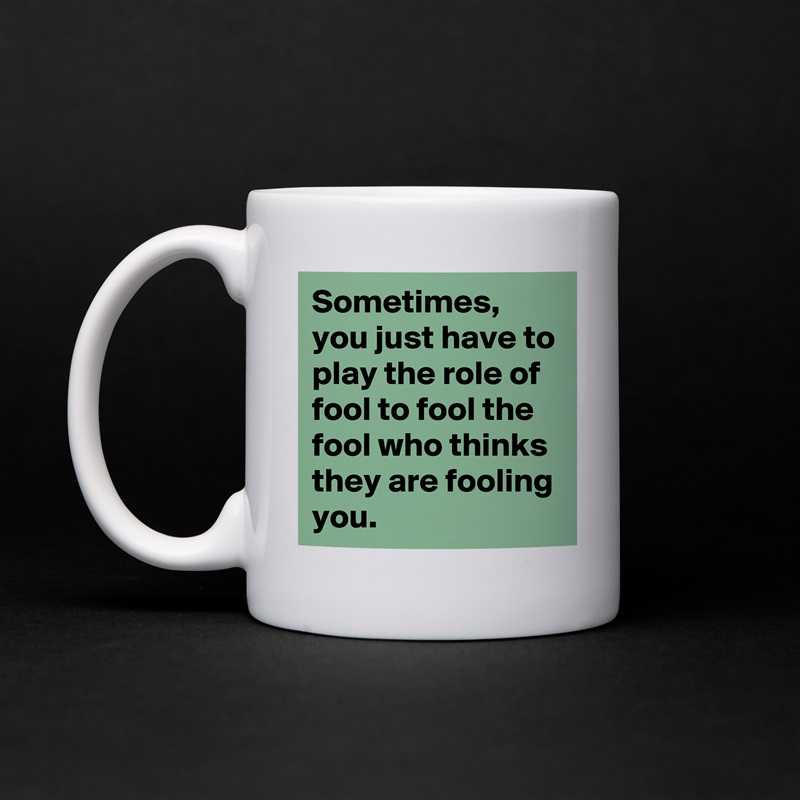 .. 9 ... 12 ... 18 ... Keep going until you reach the plate with your age.
.. 9 ... 12 ... 18 ... Keep going until you reach the plate with your age.
Meditation, like any exercise, requires regular repetition. Only then will you achieve a visible result. Start with small workouts of 5-10 minutes. Over time, you will be able to drive away extraneous thoughts and focus on the main thing.
More examples of meditations in the book "Being a Real Woman: Magical Psychology" by Dasha Gorod. In it, a popular blogger tells how to truly love yourself, reveal your femininity, find the right man and follow the wisdom of your ancestors in the modern world.
01/28/2020 Books
11/23/2018 Reviews
05/16/2018 Books
Tell your friends:
Send news
to email:
Review Posting Policy
Welcome to the reading community! We always welcome your feedback on our books, and we invite you to share your impressions directly on the website of the AST publishing house. Our site has a review pre-moderation system: you write a review, our team reads it, after which it appears on the site.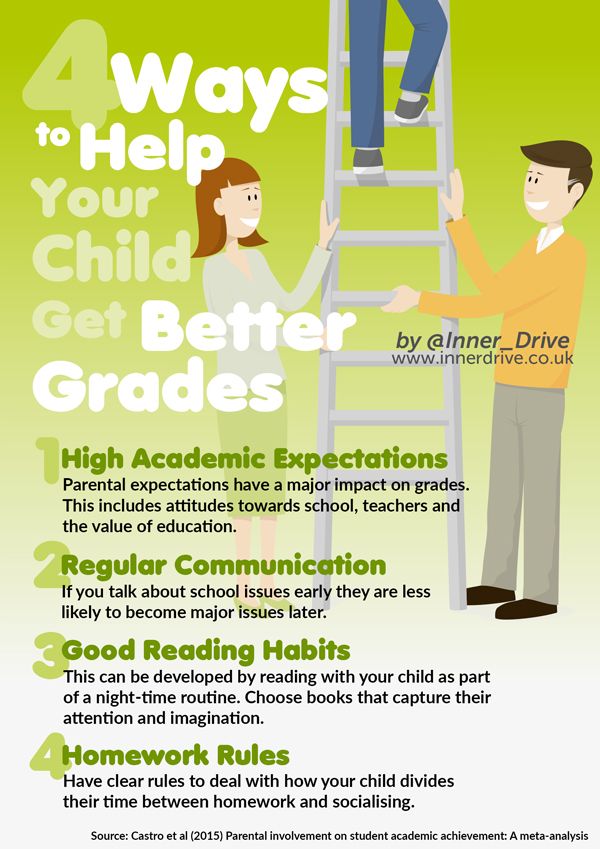 In order for a review to be published, it must follow a few simple rules:
In order for a review to be published, it must follow a few simple rules:
1. We want to see your unique experience
On the book page, we will publish unique reviews that you personally wrote about a particular book you read. You can leave general impressions about the work of the publishing house, authors, books, series, as well as comments on the technical side of the site in our social networks or contact us by mail [email protected].
2. We are for courtesy
If you didn't like the book, explain why. We do not publish reviews containing obscene, rude, purely emotional expressions addressed to the book, author, publisher or other users of the site.
3. Your review should be easy to read
Write texts in Cyrillic, without extra spaces or incomprehensible characters, unreasonable alternation of lowercase and uppercase letters, try to avoid spelling and other errors.
4. Reviews must not contain third-party links
We do not accept reviews that contain links to any third-party resources.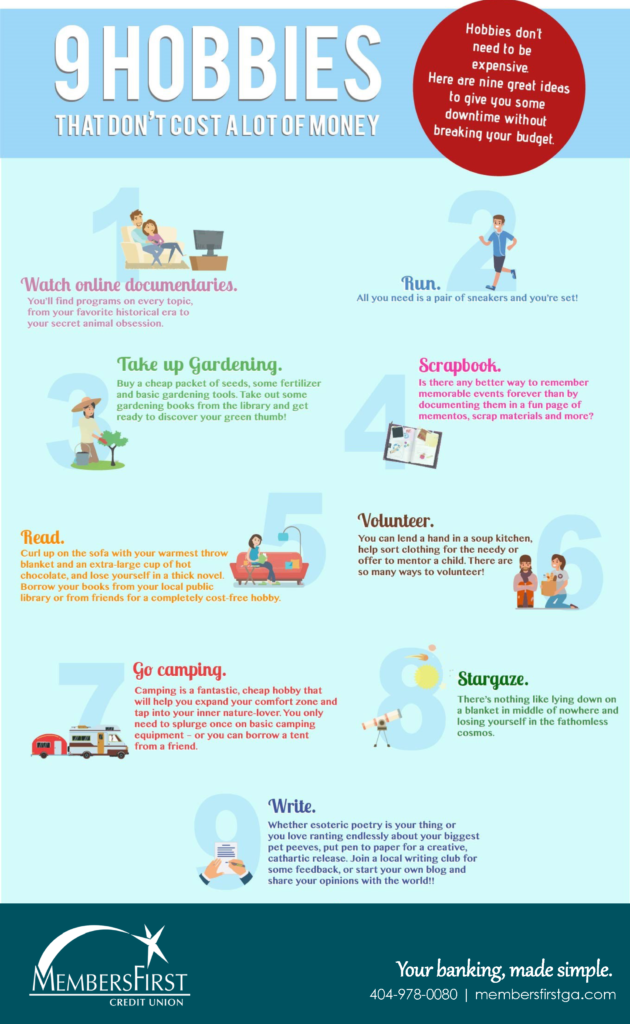
5. For comments on the quality of publications, there is a button "Complaint book"
the form "Give a complaint book."
If you encounter missing or out-of-order pages, a defect in the cover or inside of the book, or other examples of typographical defects, you can return the book to the store where it was purchased. Online stores also have the option of returning defective goods, check with the respective stores for details.
6. Review - a place for your impressions
If you have questions about when the continuation of the book you are interested in will be released, why the author decided not to finish the cycle, whether there will be more books in this design, and other similar ones - ask us at social networks or by mail [email protected].
7. We are not responsible for the operation of retail and online stores.
On the book card, you can find out in which online store the book is available, how much it costs, and proceed to purchase.

